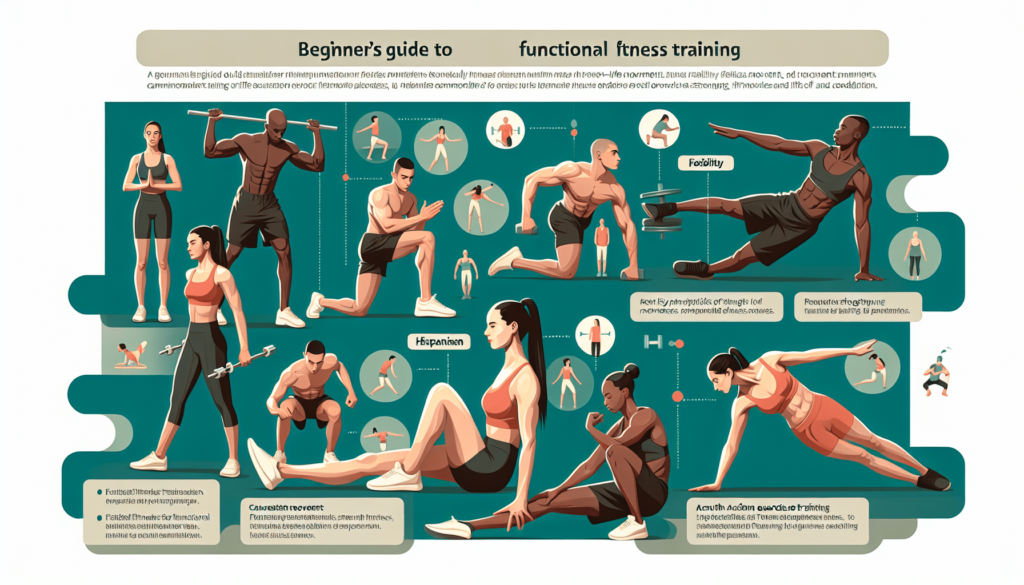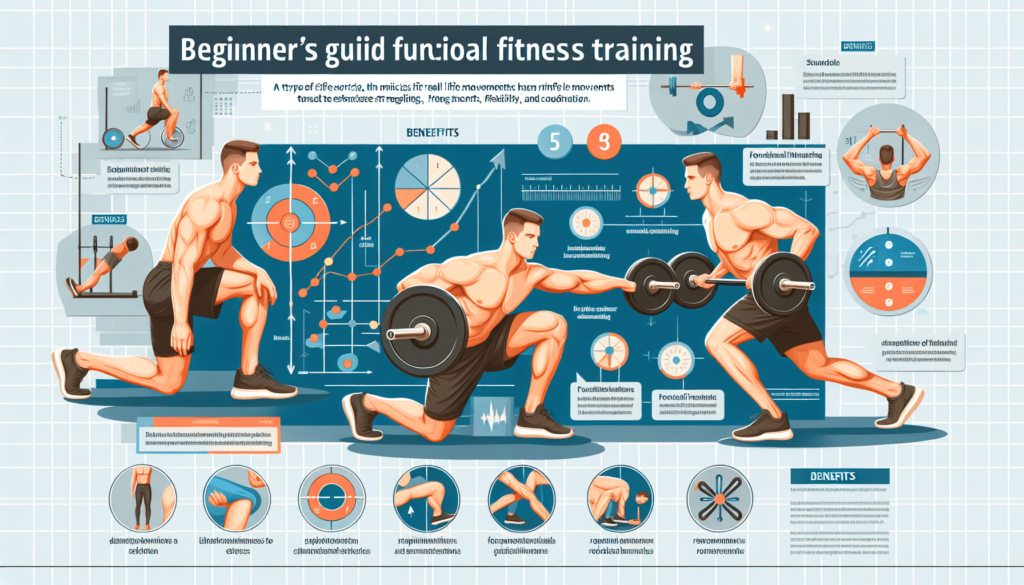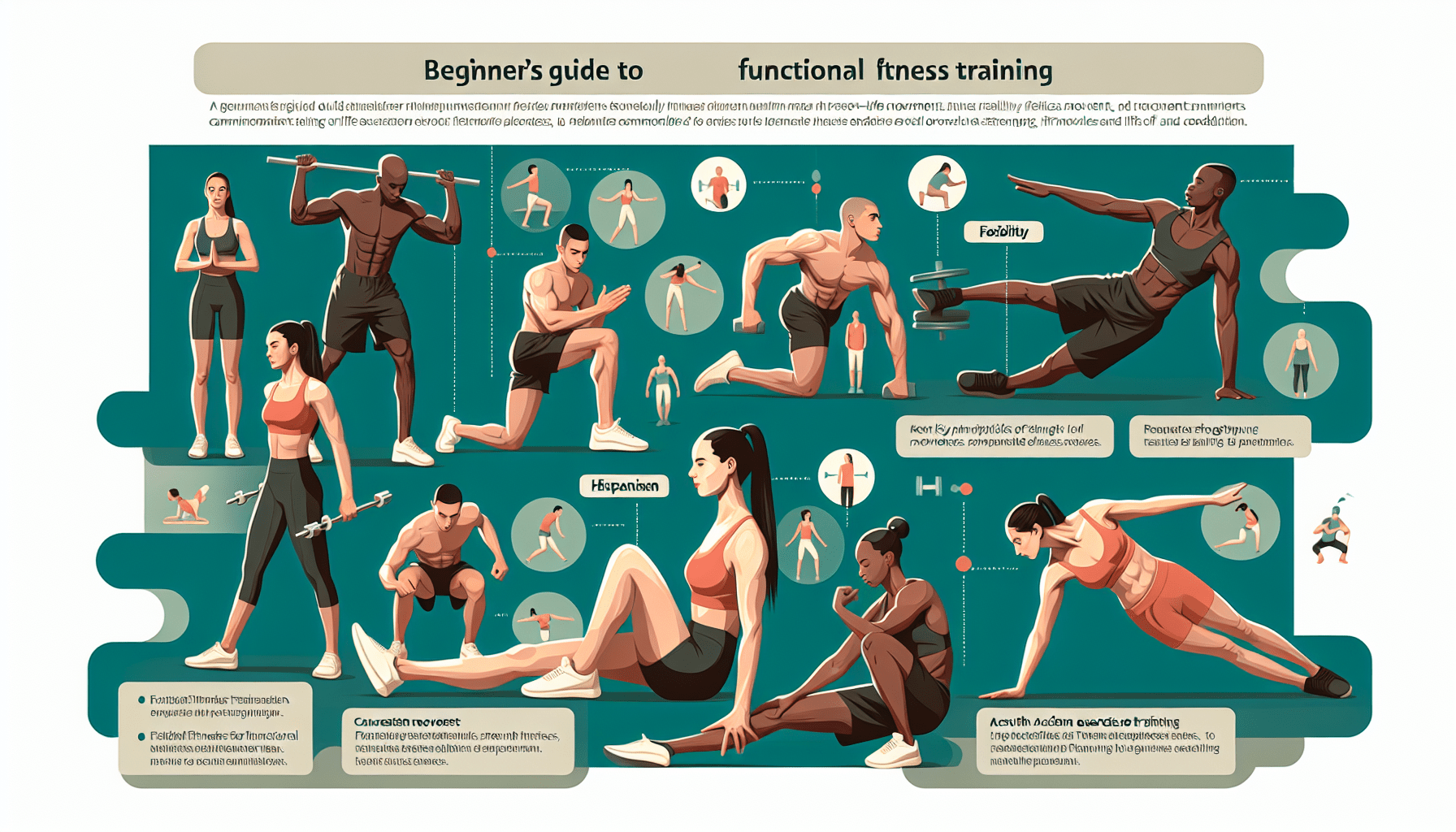So, you’ve decided to embark on a fitness journey and are wondering where to start? Look no further than this Beginner’s Guide to Functional Fitness Training. Whether you’re a complete novice or just looking to switch things up, functional fitness training offers a refreshing approach to improving your overall strength, endurance, and mobility. In this guide, we’ll take you through the basics of functional fitness training, giving you the tools and knowledge you need to kickstart your fitness journey and achieve your goals. Get ready to move, sweat, and transform your body in ways you never thought possible.
What is Functional Fitness Training
Definition
Functional fitness training is a type of exercise that focuses on training the body to perform tasks and movements that are necessary for everyday life. The main goal of functional fitness is to improve your overall strength, endurance, flexibility, and mobility, in order to make daily activities easier, reduce the risk of injury, and enhance your quality of life.
Benefits
Functional fitness training offers a wide range of benefits for individuals of all fitness levels. One of the key advantages is that it helps to improve your functional strength, which is the ability to carry out daily tasks with ease. By incorporating exercises that mimic real-life movements, such as squatting, lunging, pushing, pulling, and planking, functional fitness helps to develop the muscles needed for activities like bending down, lifting heavy objects, and maintaining good posture.
Another benefit of functional fitness training is that it enhances your endurance and cardiovascular fitness. By performing circuit training or High-intensity interval training (HIIT) workouts, you can improve your cardiovascular capacity and increase your overall stamina.
Additionally, functional fitness training helps to improve flexibility and mobility. By incorporating dynamic stretching and foam rolling into your routine, you can improve your range of motion, prevent muscle imbalances, and reduce the risk of injuries.
Overall, functional fitness training is a holistic approach that not only strengthens the body but also enhances your everyday functionality and performance.
Getting Started with Functional Fitness Training
Setting Goals
Before starting any fitness program, it’s essential to set clear and specific goals. Determine what you want to achieve through functional fitness training. Are you looking to improve your strength, lose weight, increase flexibility, or decrease pain and discomfort? By setting realistic goals, you can stay motivated and track your progress effectively.
Assessing Fitness Level
Once you’ve established your goals, it’s important to assess your current fitness level. This will help you gauge where you are starting from and identify areas that need improvement. You can assess your fitness level by measuring your body composition, testing your cardiorespiratory endurance, and evaluating your muscular strength and flexibility.
Consulting with a Professional
If you’re new to functional fitness training or have any health concerns or limitations, it’s advisable to consult with a fitness professional or personal trainer. They can provide expert guidance, assess your movement patterns, and create a customized training plan that suits your needs and abilities. A professional can also teach you proper technique and form, reducing the risk of injury and maximizing results.

Basic Functional Movements
Squat
The squat is one of the foundational movements in functional fitness training. It targets the lower body muscles, including the quadriceps, hamstrings, glutes, and calves. To perform a squat, start by standing with your feet shoulder-width apart. Lower your body as if you were sitting back into a chair, keeping your chest up and your back straight. Lower until your thighs are parallel to the ground, then push through your heels and return to a standing position.
Lunge
The lunge is another fundamental movement that strengthens the lower body, particularly the quadriceps, hamstrings, glutes, and calves. To perform a basic lunge, start by standing tall with your feet hip-width apart. Take a step forward with one foot, lowering your body until your front thigh is parallel to the ground and your back knee is nearly touching the ground. Push through your front heel to return to the starting position, then repeat on the other side.
Push-Up
The push-up is a classic exercise that targets the muscles in the chest, shoulders, triceps, and core. To perform a push-up, start in a high plank position with your hands placed slightly wider than shoulder-width apart. Lower your body by bending your elbows until your chest is just above the ground, then push back up to the starting position. To modify the push-up, you can perform it on your knees or against a wall.
Pull-Up
The pull-up is a challenging exercise that primarily targets the muscles in the upper back, biceps, and forearms. To perform a pull-up, start by gripping a bar with your palms facing away from you and your hands slightly wider than shoulder-width apart. Hang from the bar with your arms fully extended, then pull your body up until your chin is above the bar. Lower yourself back down in a controlled manner.
Plank
The plank is a core-strengthening exercise that engages the muscles in your abdomen, lower back, and shoulders. To perform a plank, start by placing your forearms on the ground, shoulder-width apart, with your elbows directly under your shoulders. Extend your legs behind you, toes tucked under, and engage your core to lift your body off the ground. Keep your body in a straight line from head to heels and hold the position for the desired duration.
Functional Fitness Equipment
Dumbbells
Dumbbells are versatile and effective tools for functional fitness training. They allow you to perform a wide range of exercises that target different muscle groups. Dumbbells can be used for movements like squats, lunges, overhead presses, rows, and bicep curls. They come in various weights, making them suitable for individuals of different fitness levels.
Kettlebells
Kettlebells are another popular piece of equipment used in functional fitness training. They resemble a cannonball with a handle and provide a unique challenge due to their uneven weight distribution. Kettlebell exercises, such as swings, Turkish get-ups, and goblet squats, engage multiple muscles simultaneously and improve functional strength, endurance, and flexibility.
Resistance Bands
Resistance bands are lightweight and portable, making them a convenient option for functional fitness training at home or on the go. They provide resistance throughout the entire range of motion, helping to strengthen muscles and improve flexibility. Resistance bands can be used for exercises like banded squats, lateral walks, bicep curls, and shoulder presses.
Medicine Ball
Medicine balls are weighted balls that come in various sizes and weights. They are commonly used in functional fitness training to improve strength, power, and coordination. Medicine ball exercises, such as wall balls, Russian twists, and medicine ball slams, engage multiple muscle groups and enhance functional movements like throwing, lifting, and twisting.

Building Strength and Endurance
Progressive Overload
Progressive overload is a fundamental principle in functional fitness training that involves gradually increasing the demands placed on the body to stimulate muscle growth and improve strength and endurance. To apply progressive overload, you can increase the weight, repetitions, or sets of an exercise. This progression challenges your muscles and forces them to adapt and grow stronger over time.
Circuit Training
Circuit training is a popular training method in functional fitness that combines strength exercises with cardiovascular exercises. It involves performing a series of exercises back-to-back with little to no rest in between. The circuit can include a mix of bodyweight exercises, resistance exercises, and cardiovascular exercises. Circuit training improves muscular endurance, cardiovascular fitness, and overall functional strength.
Improving Flexibility and Mobility
Dynamic Stretching
Dynamic stretching is a form of stretching that involves moving specific muscles or joints through their full range of motion. Unlike static stretching, which involves holding positions for a prolonged period, dynamic stretches are performed in a controlled, rhythmic manner. Dynamic stretching helps to increase blood flow, warm up the muscles, and improve flexibility and mobility.
Foam Rolling
Foam rolling, also known as self-myofascial release, is a technique used to release muscle tension, improve flexibility, and reduce muscle soreness. It involves using a foam roller to apply pressure to tight or sore areas of the body. By rolling over these areas, you can break up adhesions in the muscle tissue, increase blood flow, and improve overall mobility.
Functional Fitness Workouts
Full-Body Workout
A full-body workout is a comprehensive training session that targets all major muscle groups in one session. It typically includes a mix of strength exercises, cardiovascular exercises, and mobility exercises. Full-body workouts are efficient and time-saving, as they work multiple muscles simultaneously and provide a balanced approach to functional fitness training.
HIIT Workout
High-intensity interval training (HIIT) is a type of workout that involves short bursts of intense exercise followed by brief recovery periods. HIIT workouts are known for their effectiveness in burning calories, improving cardiovascular fitness, and boosting metabolism. HIIT exercises can include bodyweight exercises, cardiovascular exercises, and plyometric movements.
Tabata Training
Tabata training is a form of HIIT that follows a specific protocol. It involves performing exercises at maximum intensity for 20 seconds, followed by 10 seconds of rest, for a total of eight rounds (four minutes). Tabata training improves cardiovascular endurance, anaerobic capacity, and overall fitness level. It can be done with bodyweight exercises, weightlifting, or cardiovascular exercises.
Circuit Training
Circuit training, as mentioned earlier, involves performing a series of exercises back-to-back with little to no rest in between. The circuit can include a mix of strength exercises, cardiovascular exercises, and mobility exercises. Circuit training offers a challenging and efficient workout that improves muscular endurance, cardiovascular fitness, and overall functional strength.
Incorporating Functional Fitness into Daily Life
Functional Exercises at Home
You can incorporate functional fitness exercises into your daily life, even without access to a gym or equipment. Bodyweight exercises like squats, lunges, push-ups, and planks can be done in the comfort of your home. Additionally, you can use everyday objects like water bottles, cans, or chairs as makeshift weights to add resistance to your workouts. By making fitness a part of your daily routine, you can improve your functional strength and overall well-being.
Functional Movements at Work
Even at work, you can incorporate functional movements into your daily routine. Simple actions like taking the stairs instead of the elevator, sitting on an exercise ball instead of a chair to engage your core muscles, or standing up and stretching at regular intervals throughout the day can help improve your posture, flexibility, and overall fitness. Finding ways to stay active and incorporate functional movements into your workday will benefit both your physical and mental health.
Avoiding Common Mistakes
Improper Form
One common mistake in functional fitness training is performing exercises with improper form. It’s important to prioritize proper technique and form to avoid injuries and maximize results. Take the time to learn and practice correct form for each exercise, and when in doubt, consult with a fitness professional to ensure you are performing the movements correctly.
Neglecting Rest and Recovery
Rest and recovery are essential components of any fitness program, including functional fitness training. Giving your body adequate time to rest and recover allows muscles to repair and grow stronger. Overtraining and not allowing for proper recovery can lead to fatigue, decreased performance, and increased risk of injury. Listen to your body and take rest days as needed.
Overtraining
Overtraining occurs when you exceed your body’s ability to recover from the stress of exercise. It can lead to decreased performance, fatigue, increased risk of injury, and overall burnout. Avoid overtraining by allowing for proper rest and recovery, varying your workouts, and listening to your body’s signals. It’s important to find the right balance between challenging yourself and giving your body the time it needs to rebuild and recover.
Functional Fitness for Special Populations
Seniors
Functional fitness training is especially beneficial for seniors as it helps improve balance, coordination, and overall strength. It can also help prevent falls and maintain independence in daily activities. Seniors should start with low-impact exercises and gradually increase the intensity and duration as their fitness level improves. Consulting with a fitness professional who specializes in training seniors can provide guidance and ensure safety.
Pregnant Women
Functional fitness training can be modified to suit the needs and limitations of pregnant women. It helps improve strength, cardiovascular fitness, and overall well-being during pregnancy. However, it’s crucial to consult with a healthcare provider before starting or continuing any exercise program while pregnant. A fitness professional experienced in prenatal exercise can also provide guidance on safe and effective exercises.
Individuals with Disabilities
Functional fitness training can be adapted to accommodate individuals with disabilities, allowing them to improve functional strength, flexibility, and overall physical fitness. Working with a fitness professional who has experience in training individuals with disabilities can help develop a customized program based on specific needs and abilities. It’s important to focus on exercises that are safe and achievable for each individual, promoting independence and enhancing overall well-being.
In conclusion, functional fitness training is a versatile and effective approach to improving strength, endurance, flexibility, and overall functionality. By incorporating functional movements, using appropriate equipment, and following proper training principles, you can achieve your fitness goals and enhance your daily life. Whether you’re a beginner or have specific fitness needs, functional fitness training can be customized to suit your abilities and help you reach your full potential.
